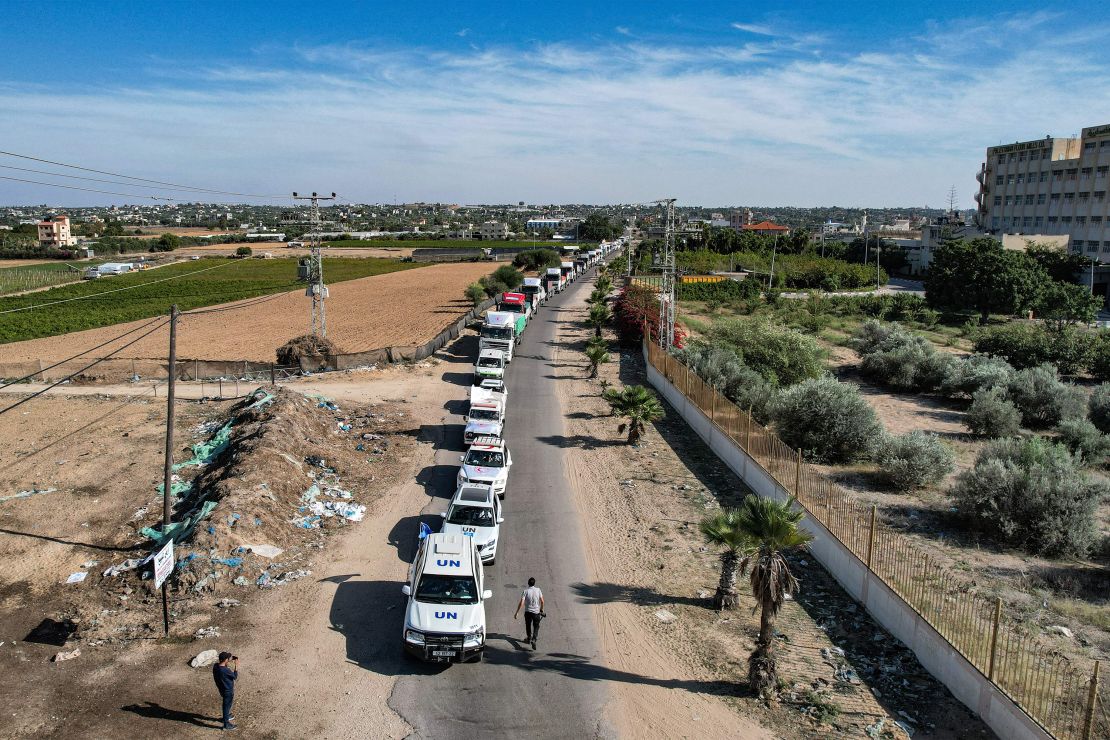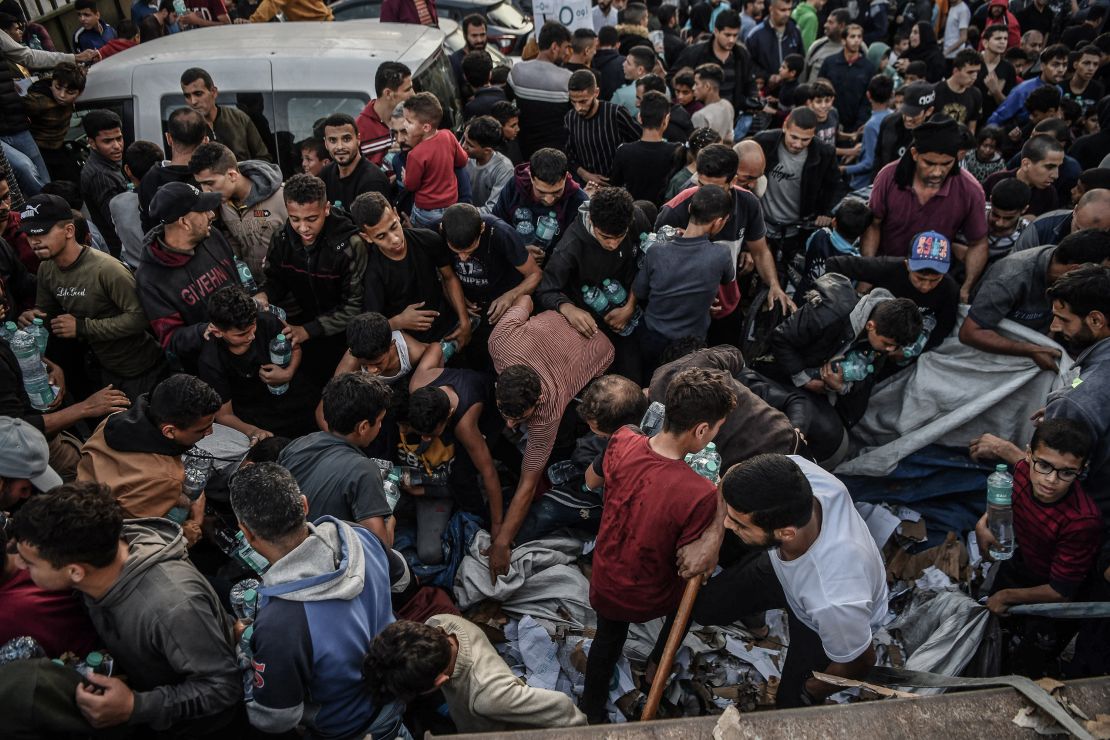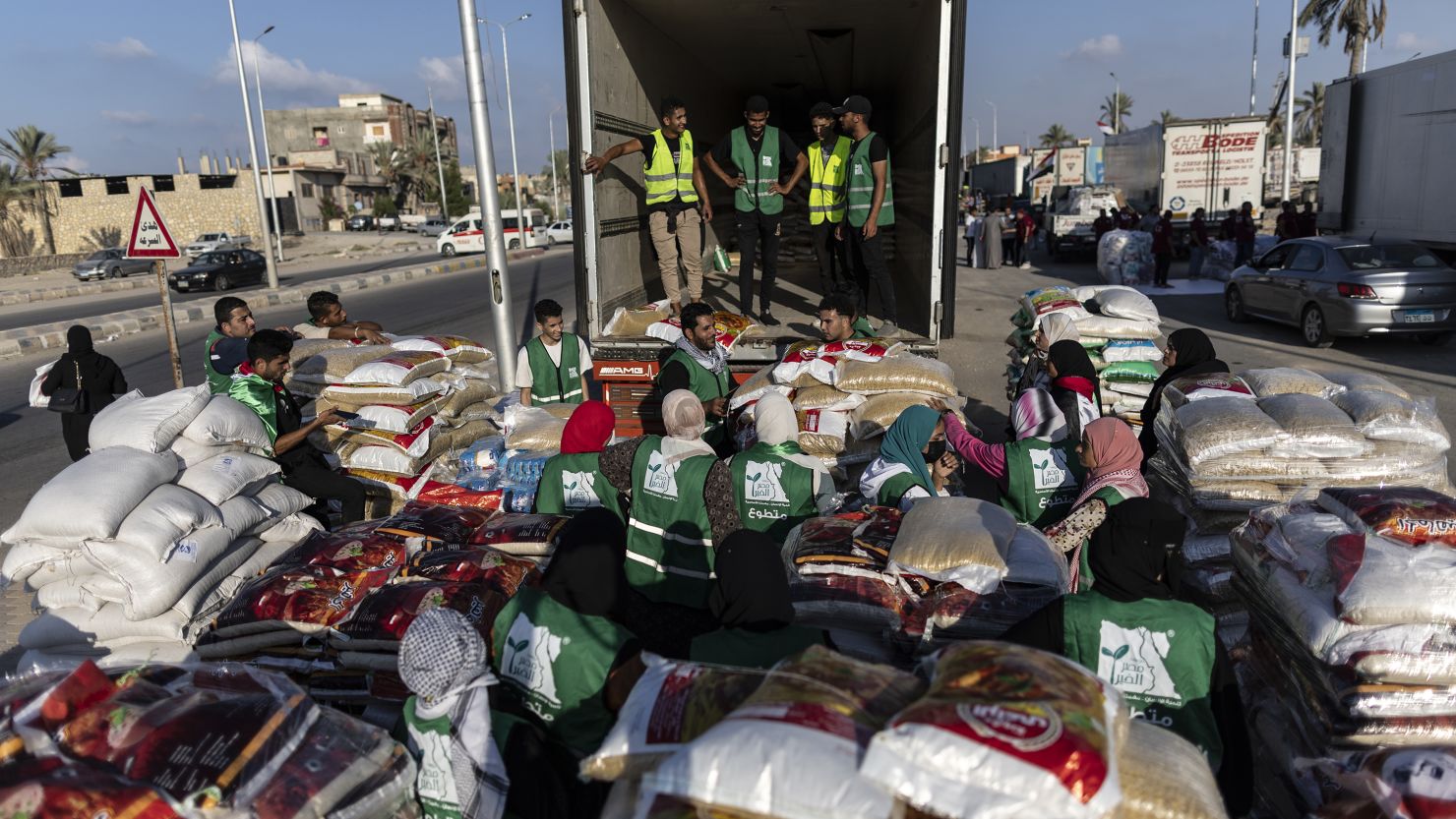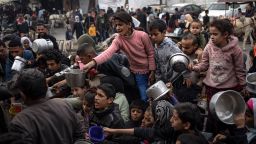Editor’s Note: A version of this story appears in CNN’s Meanwhile in the Middle East newsletter, a three-times-a-week look inside the region’s biggest stories. Sign up here.
Lengthy inspections, rejected humanitarian aid and Israeli bombs raining down. Those are some of the hurdles to relief reaching the 2.2 million Palestinians in war-torn Gaza.
The United Nations’ Under-Secretary-General for Humanitarian Affairs and Emergency Relief, Martin Griffiths, has described the process as “in all practical terms, impossible.”
Gaza was placed under a complete Israeli siege on October 9, when Defense Minister Yoav Gallant said he would halt the supply of electricity, food, water and fuel to the enclave after Hamas attacked his country, killing 1,200 people and taking more than 250 hostages. Israel has since begun allowing some aid to enter.
Some four months since Israel began its retaliatory military campaign in Gaza, it is yet to complete its objective of destroying Hamas and the war rages on, leaving most of Gaza’s civilian population at the mercy of aid that must be approved by Israel.
While aid reaching the Gaza Strip was insufficient even before October 7, according to the UN, the humanitarian situation has been greatly hit by the conflict, which has killed more than 27,000 people, according to the Hamas-run health ministry in the enclave, and displaced more than 1.9 million others.
Getting any form of relief into Gaza is a long and arduous process, aid workers and the UN say.
An average of 95 aid trucks per day entered Gaza between October 10 and February 1, according to the Palestinian Red Crescent, down from 500 commercial and aid trucks a day before the war, when Palestinians weren’t facing mass displacement and starvation. Some 2 million Gazans are dependent on UN aid now.
“The humanitarian operation and the delivery of trucks continues to be cumbersome and continues to be unnecessarily complex,” Juliette Touma, director of communications for the UN’s agency for Palestine refugees (UNRWA), told CNN.
Relief operations are expected to be further hampered after the United States and other top donors suspend funding for UNRWA, the main agency responsible for aid distribution in Gaza. The donors pulled their funding over allegations by Israel that some of its staff were involved in the Hamas attacks.
UNRWA has warned it may be forced to halt its operations by the end of the month due to lack of funds. And on Thursday, UNRWA Commissioner-General Philippe Lazzarini said the agency has not been able to deliver food into Gaza since January 23, adding that since the beginning of the year, “half of UN’s aid mission requests to the north were denied.”
“The UN has identified deep pockets of starvation and hunger in northern Gaza where people are believed to be on the verge of famine,” Lazzarini said on X.
Following a CNN request for comment, Israel’s Coordinator of the Government Activities in the Territories (COGAT) said Israel operates in accordance with international law and “is neither preventing nor blocking the entry of humanitarian aid but rather facilitates the transfer of aid by the international aid organizations in accordance with operational conditions in the field.”
Israel has also been accused of deliberately obstructing aid. Egypt, which shares a border with Gaza, has charged that the policy is “systematic, and aimed at pushing Palestinians to leave Gaza under the continued bombing and siege,” an Egyptian foreign ministry spokesperson said in November.
Israel maintains that it is working to respond to the needs on the ground in Gaza, saying that “it is at war with Hamas and not the people of Gaza.” Last month, it told the International Court of Justice that “there is no limit on the amount of food, water, shelter or medical supplies that can be brought into Gaza.”
Here’s why aid is slow to get into Gaza:
Limited entry points
Before the war started, Israel restricted all access to and from Gaza by sea and air and had land crossings under tight control. It had two functional crossings with the enclave: Erez, which was for the movement of people, and Kerem Shalom, for goods.
Gaza also has one crossing with Egypt, at Rafah, which is run by Egyptian authorities. While Israel has no direct control over this crossing, it monitors all activity in southern Gaza. Egyptian Foreign Minister Sameh Shoukry previously told CNN that the Rafah crossing has been repeatedly bombed, causing disruptions in aid.
Movement through all three crossings was already heavily restricted before the war, as Israel imposed a blockade of the territory with Egypt 17 years ago. After the current war began, Erez and Kerem Shalom were shut for several weeks. On October 21, Rafah began allowing aid to trickle in.

In mid-December, Israel began conducting security checks on aid for Gaza at its own crossings before it was sent to Rafah. It said at the time that the move would double the volume of aid delivered through Rafah, but aid workers have said the additional inspection points were insufficient, according to the UN. Egypt criticized the measures as unreasonable, saying it hinders the flow of aid. Following pressure from the US, Israel began allowing aid trucks to pass through Kerem Shalom in late December.
Aid delivery through Egypt is also hampered by the fact that the Rafah crossing is designed as an entry point for people, not goods, making it difficult for large convoys to pass through.
Long inspections, rejected items
The war has prompted Israel to conduct more stringent checks on aid as it seeks to prevent the entry of what it calls “dual-use equipment,” products it says are “intended for civilian use but liable to serve military needs for the strengthening of Hamas.”
Trucks carrying aid must pass through three layers of inspection before they can enter the enclave, Griffiths, the UN under-secretary-general, has said.
The long queues for inspection have led to bottlenecks at the Rafah crossing, the UN’s World Food Programme (WFP) said last month, adding that among items deemed “dual use” by Israel are power generators, crutches, field hospital kits, inflatable water tanks, wooden boxes of children’s toys and, “perhaps most depressingly, 600 oxygen tanks.”
The list of rejected items is only growing, Griffiths said.
Protesters blocking trucks
Israeli protesters have more than once blocked trucks carrying humanitarian aid for Gaza via Israeli crossings. They have demanded that the aid only be delivered in exchange for the release of the hostages. The protesters are with the “Tsav 9’” movement, a grouping of families of hostages, fallen soldiers, demobilized reservists, and displaced Israeli civilians.
Israel says more than 100 hostages are still held captive in Gaza.
Some of the protests have caused aid disruptions lasting days, UNRWA said.
Following the protests, Israel declared Kerem Shalom and the Nitzana crossing with Egypt military zones, a move that led to some arrests, according to Israeli media.
Disruptions were renewed this week as hundreds of Israeli protesters returned to Kerem Shalom Tuesday.
Risk of bombardment
Once relief enters Gaza, Israeli bombardment, damage to roads from airstrikes, communications blackouts and mass displacement impede distribution within the enclave.
“It becomes very difficult to make phone calls to coordinate, to organize the delivery of humanitarian assistance,” Touma, the UNRWA spokesperson, said. In the wake of the war, Israel cut electricity to Gaza and service providers said airstrikes destroyed vital communications network infrastructure. The territory has since experienced multiple communication blackouts, leaving Palestinians unable to contact each other or the outside world.
Humanitarian workers cannot move safely across the strip. UN trucks carrying aid have repeatedly come under Israeli fire, according to UNRWA. On February 5, an UNRWA truck waiting to take aid into northern Gaza was hit by Israeli naval gunfire, the agency said, adding that no one was injured. The IDF told CNN that it is looking into the incident.

“It is extremely difficult to deliver humanitarian assistance under fire,” Touma said on Monday. “We fear for (workers’) lives because no place is safe in Gaza.”
In recent days, Israel has pressed its military offensive further into central, southern and in neighborhoods across northern Gaza – where UN agencies have struggled to reach displaced civilians facing starvation, dehydration and deadly disease.
On Friday, the World Food Programme said it had been unable to reach northern Gaza City for the third time in a week, as a full-scale famine looms. Touma says Israeli authorities must approve humanitarian convoys waiting to enter the north at the Wadi Gaza checkpoint that separates the north and south of the strip. Beyond that, she said, there are around 300,000 people “living in desperate conditions.”
When aid does enter the shelters housing displaced Palestinians, Touma told CNN, aid workers are sometimes unable to regulate distribution due to overcrowding.
“Then you have overwhelming needs on the ground that are way, way beyond the capacity of humanitarian agencies because not much aid is coming in,” Touma said, adding that Gazans are “absolutely tired, fatigued, desperate and so quite often what happens is that people come to the humanitarian convoys, and they help themselves to the convoys.”
CNN’s Sana Noor Haq contributed to this report.



